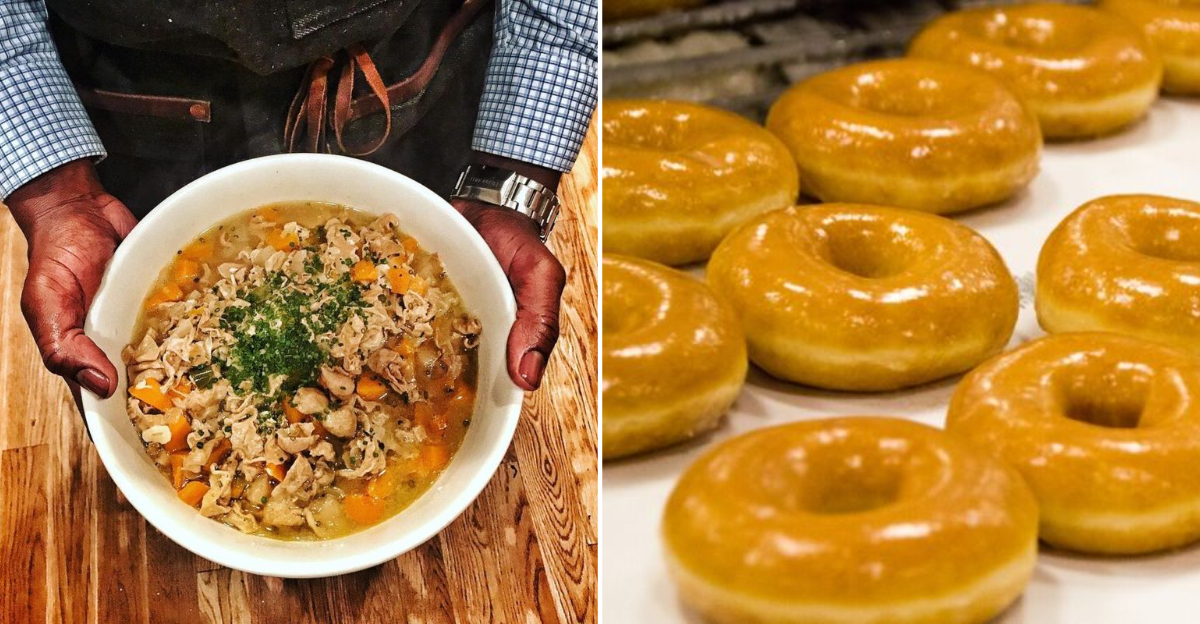7 North Carolina Foods People Avoid & 7 Everyone Can’t Stop Talking About

North Carolina’s food is a living history lesson, shaped by the state’s mountains, farmland, and coastline.
Some dishes are time-honored staples passed down for generations, while others are bold local specialties you won’t find anywhere else.
Together, they tell the delicious and sometimes unexpected story of the Tar Heel State.
1. Livermush: The Breakfast Mystery
Livermush makes newcomers pause with its unappetizing name and gray appearance. This combination of pig liver, head parts, cornmeal, and spices gets sliced and fried until crispy.
Popular in western North Carolina since German settlers arrived, locals swear by it with eggs or on sandwiches. My grandfather ate it every morning for 50 years, claiming it kept him strong as an ox.
Most outsiders can’t get past the strong liver flavor and unusual texture.
2. Chitlins: The Polarizing Delicacy
Chitlins (or chitterlings) are cleaned and cooked pig intestines that divide North Carolinians into love-or-hate camps. The lengthy cleaning process and distinctive aroma drive many people away before they even try them.
Deeply rooted in Southern African American cuisine, these were born from making use of every part of the animal during times when food was scarce.
The smell during cooking is so notorious that some families have special ‘chitlin cooking’ days when sensitive noses leave the house.
3. Eastern NC Fish Stew with Eggs: Community Tradition
This hearty coastal tradition features whole eggs cracked directly into a pot of fish stew, creating a protein-packed meal that startles the uninitiated. The combination of fish, potatoes, onions, and poached eggs creates a unique texture many find off-putting.
I remember my first fishing trip with my uncle when he made this at dawn over a campfire. The egg whites blended with the broth while the yolks stayed intact. I was hooked instantly.
Traditional fishing families swear by its energizing properties for long days on the water.
4. Red-Eye Gravy: Coffee in Your Gravy?
Red-eye gravy startles visitors with its unusual main ingredient: coffee. This thin sauce made from ham drippings and black coffee creates a salty-bitter combination that many find strange on first taste.
The gravy gets its name from its reddish hue and the circular shape it forms when poured over grits, resembling a bloodshot eye.
While beloved by old-timers across the state, younger generations and newcomers often reach for traditional gravy instead, finding the coffee-meat combination too jarring.
5. Ramps: The Stinky Spring Delicacy
Ramps bring a pungent garlic-onion aroma that lingers for days on your breath and skin. These wild mountain leeks grow in Appalachian North Carolina and cause social distancing long before it was mandated.
Local mountain folks celebrate their arrival each spring with festivals, while city dwellers often avoid ramp-eaters entirely. Growing up in the mountains, our school would practically empty during ramp season as kids stayed home to avoid being teased for the smell.
Despite their overwhelming aroma, culinary enthusiasts prize their unique flavor.
6. Peanut Butter & Mayo Sandwiches: Unusual Combo
Peanut butter and mayonnaise sandwiches perplex outsiders but remain a nostalgic comfort food for many North Carolinians. This Depression-era creation combined two affordable, shelf-stable spreads into a protein-rich meal.
Some devotees add banana slices or pickle relish for extra flavor dimensions. The creamy-savory combination creates a unique mouthfeel that’s surprisingly satisfying if you can get past the concept.
Modern nutritionists might cringe, but generations of Carolina schoolchildren grew up with these sandwiches in their lunchboxes.
7. Boiled Peanuts: Slimy or Sublime?
Boiled peanuts transform the familiar crunchy snack into soft, wet legumes with a texture that horrifies the uninitiated. Roadside stands throughout North Carolina sell these soggy treats, often flavored with salt and cajun spices.
The soft, bean-like consistency makes many first-timers spit them out immediately. Last summer, I watched my Northern cousin’s face contort in confusion when the shell opened to reveal what he called “wet peanut mush” instead of the crisp nut he expected.
Yet locals slurp them down by the bagful, especially during hot summer months.
8. Lexington-Style Barbecue: Pork Perfection
Lexington-style barbecue showcases slow-smoked pork shoulders with a vinegar-based sauce that’s been enhanced with a touch of tomato or ketchup. The distinctive red-tinged sauce perfectly complements the hickory-smoked meat that falls apart at the touch.
Each bite delivers a harmonious blend of smoke, tang, and subtle sweetness. Locals debate which pit master reigns supreme, with family loyalties to specific restaurants spanning generations.
The traditional serving comes with red slaw (made with the same sauce instead of mayo) and hushpuppies for the complete experience.
9. Eastern NC Whole-Hog Barbecue: The Original
Eastern North Carolina whole-hog barbecue represents barbecue in its purest form. Entire pigs cook slowly over wood coals, then get chopped together, mixing all cuts from ham to shoulder with crispy skin bits called cracklins.
The sauce contains no tomato, just vinegar, pepper flakes, and spices. My first pig-picking at age seven became a flavor memory that defined my understanding of what real barbecue should taste like.
The tradition of community pig-pickings brings together families and neighbors around massive cookers for celebrations and fundraisers.
10. Calabash-Style Seafood: Crispy Coastal Treasure
Calabash-style seafood features lightly breaded, quickly fried fresh catches from North Carolina waters. The delicate coating lets the seafood’s natural flavors shine through without heavy batter overwhelming the star ingredients.
Named after the small fishing town of Calabash near the South Carolina border, this cooking style has spawned countless seafood restaurants across the state. The tradition began with small fish houses serving the day’s catch to hungry fishermen.
Locals know the best places serve heaping platters of shrimp, flounder, and oysters still sizzling from the fryer.
11. Cheerwine: The Cherry-Red Nectar
Cheerwine captivates taste buds with its deep cherry flavor and extra carbonation that sets it apart from ordinary sodas. This ruby-colored soft drink was born in Salisbury, NC, in 1917 during a sugar shortage and has maintained its cult following for over a century.
Despite the name, it contains no alcohol, just a uniquely sweet cherry taste with more fizz than typical sodas. When I moved away for college, care packages from home always included Cheerwine because nothing else could satisfy that specific craving.
Locals use it in everything from barbecue sauce to desserts.
12. Krispy Kreme Original Glazed: Winston-Salem’s Gift
Krispy Kreme doughnuts inspire devotion with their melt-in-your-mouth texture when the Hot Light glows. Born in Winston-Salem in 1937, these pillowy rings of perfection come bathed in a sweet glaze that crackles slightly when fresh.
The transparent windows at original locations let customers watch the hypnotic production line. North Carolinians plan routes around Krispy Kreme locations, making detours when the Hot Light signals fresh doughnuts coming off the line.
The simple glazed remains the standard against which all doughnuts are judged.
13. Cook Out Milkshakes: 40+ Flavors of Joy
Cook Out milkshakes elevate fast food desserts to legendary status with over 40 flavors that range from classic chocolate to unique combinations like blueberry cheesecake. These thick concoctions require sturdy straws and often spoons to enjoy properly.
The North Carolina-based chain has sparked debates about which flavor reigns supreme, with seasonal offerings creating limited-time frenzies.
During college finals week, my roommates and I would reward ourselves with late-night Cook Out shake runs, each of us loyal to our favorite flavors.
The reasonable prices make them an affordable luxury.
14. Crystal Coast Shrimp Burger: Coastal Sensation
Crystal Coast shrimp burgers feature a generous pile of crispy fried local shrimp. The shrimp are lightly breaded and fried until golden.
Served on a soft bun with tartar sauce, lettuce, and tomato, they represent the essence of North Carolina coastal cuisine. Small seafood shacks along the Crystal Coast each claim to have the original or best version, with fierce local loyalties.
The combination of fresh seafood and casual presentation keeps people coming back summer after summer.
